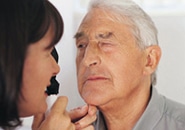GLAUCOMA TREATMENT IN LOUISVILLE
Koby Karp Doctors Eye Institute specializes in Glaucoma treatment. Whether you are experiencing Glaucoma symptoms or getting information for a relative or a friend, we have provided a great deal of information here to answer some of your questions.
ABOUT GLAUCOMA
The term “glaucoma” refers to a group of diseases, not a single disease. It is not easy to define the term precisely as it is not as simple as “high pressure” in the eye. The underlying problem is gradual death (or the potential for this degeneration) of nerve cells in the optic nerve. This can lead to eventual loss of peripheral vision and finally, total blindness. Most forms of glaucoma are associated with high eye pressure. This pressure is measured as part of a complete eye examination. High eye pressure is a risk factor for glaucoma. It is currently the only risk factor for glaucoma which can be altered by treatment. Therefore, people tend to think of glaucoma and high eye pressure as the same thing, but it is not so simple.

As millimeters of mercury, the normal eye pressure is typically between about 8 and twenty one. If the pressure is found to be higher than this, or if there are signs of optic nerve damage or other risk factors for glaucoma, we will often recommend further testing of the optic nerve function. This may include visual field testing to see the extent of any peripheral loss.
Zeiss Optical Coherence Tomography (OCT) is a method of detecting and following glaucoma damage, possibly demonstrating a change in nerve cells before any peripheral vision is lost, therefore detecting glaucoma earlier. This technology represents an advance in management of glaucoma, as early detection is important. Optic nerve cells which die cannot be restored, so once we know that deterioration is happening, we can recommend treatment. The Zeiss OCT takes a special photograph of the area around the optic nerve, using light characteristics to measure the layer of cells which are affected in glaucoma. This may begin to show changes before any vision is lost and we can recommend treatment at this earlier time.
The visual field test involves active participation. As you look into a large white bowl shaped ‘perimeter’, small dim lights will blink in the peripheral vision. As you press a button to indicate that you see the light, the computer keeps track and reconstructs a visual field. This test takes 15 to 30 minutes and is often done yearly to follow glaucoma. The goal of treatment of glaucoma is to halt the progressive loss of vision. So if the field test is followed from year to year, this is helpful information.
Glaucoma may be categorized into two main categories. This is because the types of symptoms and findings and treatments are quite different. Open angle glaucoma (OAG) is the more common category, the ‘garden variety’ of glaucoma. This means that the iris cornea angle is open, and flow of fluid is not obstructed before reaching the “angle”, where fluid leaves the chamber. Within the angle meshwork, the fluid meets high resistance. This is normally the primary, inherited type of OAG or POAG. Occasionally, some material may block the meshwork system, such as pigment material or inflammation cells or blood cells. These may be categorized as Secondary OAG (SOAG). The treatments are similar, involving long-term control of eye pressure.
Narrow Angle Glaucoma, Acute Angle Closure and Angle Closure Glaucoma are the other broad group of glaucomas. With these forms of glaucoma, the angle where fluid is to leave the eye is blocked in some way by the iris edge. Some people have naturally small eyes, often farsighted, and a crowded anterior chamber. Fluid flow can actually be blocked due to the iris covering the angle, and a sudden extreme rise in pressure may occur.

This is more sudden than the normal “open angle” forms of glaucoma. The pressure may rise so high as to cause pain and redness and blurry vision. Sometimes on examination, there is evidence of wide pressure fluctuations without symptoms, and possible damage to the optic nerve (ACG). The normal treatment for this form of glaucoma is laser treatment to create a small hole in the edge of the iris. This is performed in the office, and it is possible that this can actually “cure” the problem. Some people may still need eye drops on a regular basis.
Treatment of most patients with glaucoma usually begins with eye drops. There are several commonly used drops, many are once or twice daily doses. Some patients may be candidates for laser treatment to lower eye pressure. Selective Laser Trabeculoplasty (SLT) is a relatively recent advance in treatment of open-angle glaucoma. Drops can be altered based on effectiveness and side-effects; laser treatment can be used to lower pressure, and surgical treatment is another option for lowering of pressure.
DR. SCOTT HOFFMAN DISCUSSES GLAUCOMA
CAUSES OF GLAUCOMA
In most types of glaucoma, the eye’s drainage system becomes clogged so the intraocular fluid cannot drain. The fluid builds up thereby causing the pressure to build inside the eye. High pressure damages the sensitive optic nerve ultimately resulting in loss of vision.
To read the subject entirely please click here to view the pdf.




